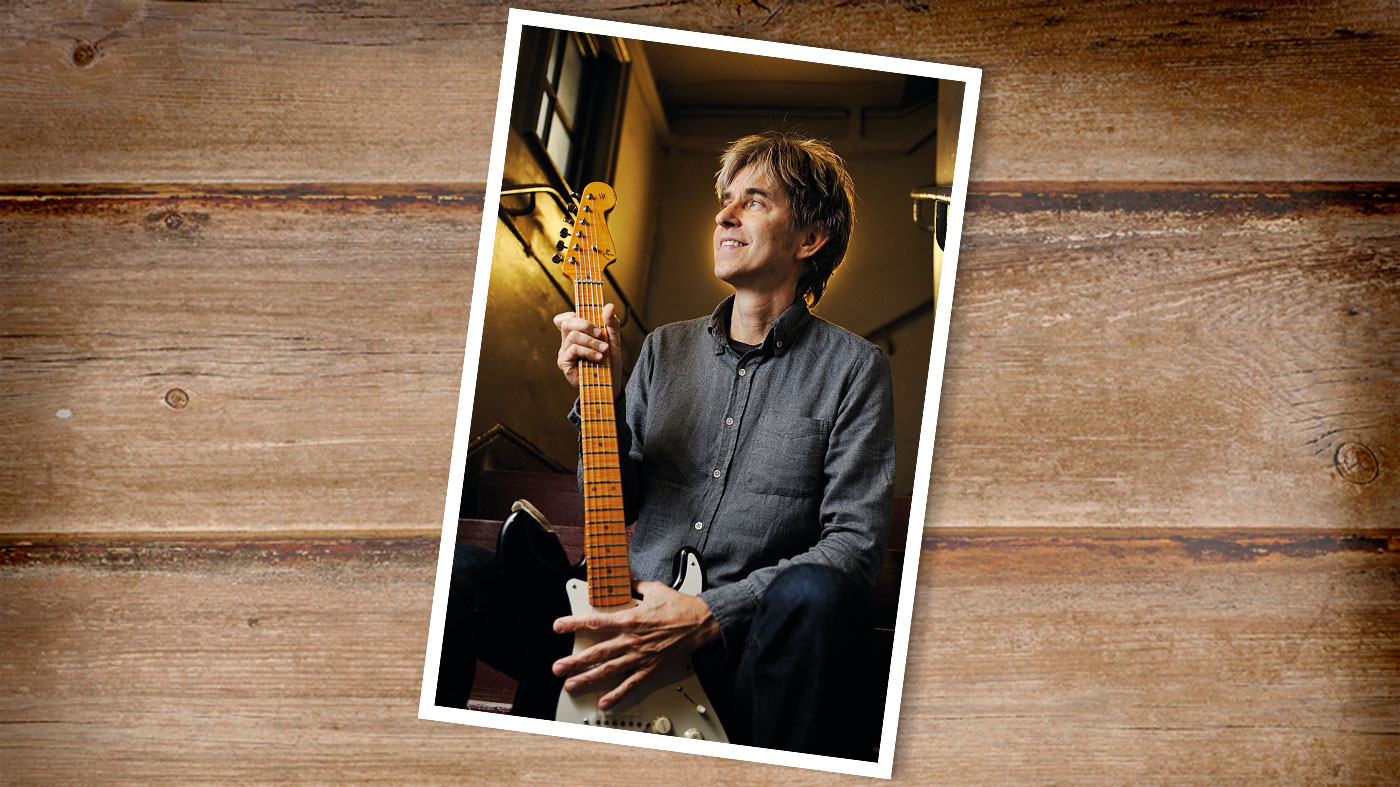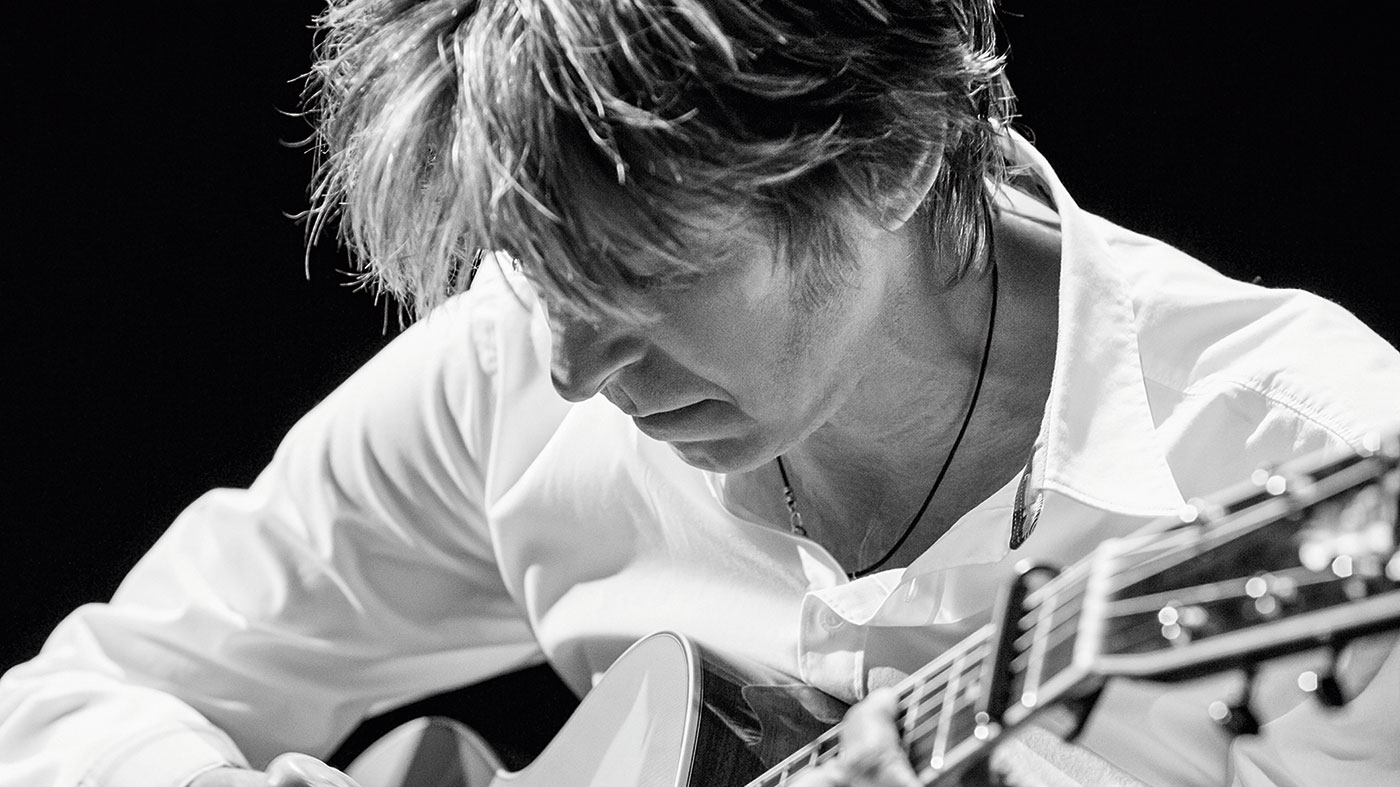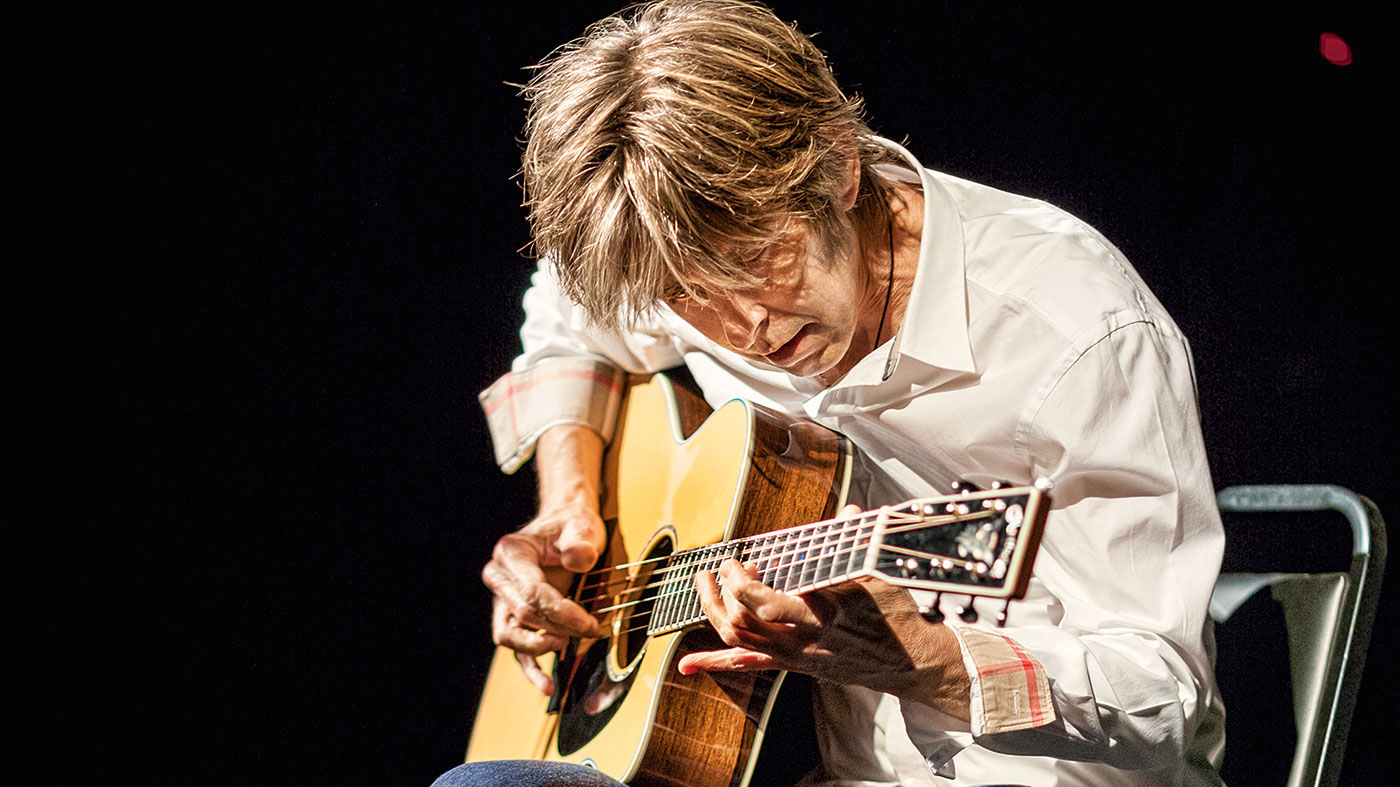Eric Johnson talks acoustic tone tips, technique and recording
Guitar great on unplugging for acoustic album EJ

Introduction
ACOUSTIC WEEK: A new acoustic album from one of the acknowledged connoisseurs of tone, Eric Johnson, proves to be as much of a masterpiece as any of his celebrated electric work…
Back in the mid 1980s, Eric Johnson was a name whispered about by the guitar-playing cognoscenti who had managed to track down EJ’s album, Tones. Here was a guitarist who was doing something truly different in a decade where instrumental guitar had become samey. By the time Ah Via Musicom was released five years later, Johnson’s name was synonymous with tasteful, chop-laden soloing and songwriting finesse.
I’ve been wanting to do it for years and I’ve just kind of always put it off because I get involved in some electric tour
He also became known for his unforgiving attitudes towards tone, famously declaring in our sister publication, Guitarist, that he could detect a tonal difference between Duracell and other makes of battery deployed in effects pedals.
His torturous attention to detail and forthright self-criticism has extended to his recent acoustic album, too: “I had a bunch of acoustic songs and some of them you record and you go, ‘Ah, that’s not really that good…’ Other times I would record and not get a performance that was good enough.”
The album in question, simply titled EJ, is another surprise for the guitar world. With instrumentals interspersed with songs - some home-brewed, others covers - the guitar styles veer from the romantic, nylon string driven Surinidad to fiery, Chet Atkins and Tommy Emmanuel influenced fingerstyle showstoppers like The World Is Waiting For The Sunrise. After years of producing electric albums, why, we wondered, had he decided to unplug?
“I’ve been wanting to do it for years and I’ve just kind of always put it off because I get involved in some electric tour, new record or stuff just coming up here and there. It’s been in the back of my mind for years to make a record and actually there’s three songs on there that I actually recorded years ago.
“I just decided I need to get in and do this thing. I actually have done a series of acoustic solo tours - a handful of them - over the last seven or eight years. Every now and then I’d do one and then we never had an acoustic record and people started asking, ‘Well you’re doing these shows but you don’t have an acoustic record’.”
Don't Miss
Eric Johnson: the 10 greatest guitar tones of all time

A new side
Do you enjoy playing acoustic guitar?
“It’s something I’ve always done, just sitting around my living room playing piano or acoustic guitar, but for whatever reason I never really included it in my repertoire of what I show to the public. At some point I just thought I should show all sides that interest me and that I try to work on.”
Which came first with you, playing electric or acoustic guitar?
My premise for doing the record was to perform the stuff in the studio. I wanted to keep it as live as possible
“I started on electric. I started playing when I was 11 and I didn’t start playing acoustic till I was about 17. I got my first acoustic and started dabbling around with it, writing songs and stuff. I would play it a little bit in electric shows and stuff and then I started getting a little more serious about it in my late 20s.”
What about influences as far as acoustic players are concerned?
“Originally I would say Simon and Garfunkel and Joni Mitchell. I was a huge fan of Joni’s records Ladies Of The Canyon and Blue. Solo, intimate guitar with voice: James Taylor, Bert Jansch, Paul Simon and I really came to appreciate Bob Dylan and, later on, I got into Shakti, Tommy Emmanuel and Michael Hedges - I really was a big Michael Hedges fan.”
How did you set about gathering the material for the album?
“My premise for doing the record was to perform the stuff in the studio. I wanted to keep it as live as possible, so I would just go in the studio and record the songs two or three times and see if I got a good take and if I didn’t I’d revisit it a few days later. Some of the songs just needed more work or I wasn’t performing them live appropriately - so I’ve got a bunch of rough versions of more acoustic tunes. I want to try to do a second acoustic record, hopefully next year.”
You’ve got a mix of originals and covers as well; Hendrix’s One Rainy Wish, for instance. What was the motivation to put that on the album?
“I like all of Hendrix’s music, but I’ve always loved that song. I just thought that I’ve played that tune with the electric band and I need to try to do a different arrangement, a different approach, because any songs that are just really good can be interpreted in a variety of different ways. So I thought it might be interesting to try a whole different approach on it.”
The instrumental section at the end develops into a jazz feel…
“Yeah, yeah. Mitch Mitchell would always have that swing to his playing which really gave a beautiful feel to Hendrix’s music. I thought that Mitch was equally important in the beauty of Jimi’s music. It’s a cool song, it’s in 6/8 and it has that kind of swing to it which lends itself to different ways of interpretation.”

Fingerpicking good
Are there any other special moments on the CD for you?
“Song For Irene is a song I wrote for my mom; her name is Irene. I just wanted to write a soft tempo acoustic piece that kinda had James Taylor-type fingerpicking in it. I like the song Wonder only because I like the lyrics and I like the meaning of it and stuff. I always enjoy that tune. It’s kinda just the mystery of life: you can’t really quantify or figure out why things are the way they are, you just enjoy and appreciate the magic.”
You swap over to nylon-string for Surinidad - it’s a different feel from steel string, don’t you find?
“Absolutely, yeah. I’m no pro on nylon-string, as far as playing it traditionally. I enjoy the sound of it and keep practising, trying to work on it. That particular tune was actually just an improv. We just turned on the recorder and I just jammed; I’m not even sure what I played on that, but I guess the whole intent was to try and capture an improvisational moment.”
I guess, for me, when I decided I wanted to play acoustic, I wanted to do it a more fingerpicking way
You’re known principally as an electric player. How do you find you have to adjust technique over to acoustic? Acoustic, in general, is less forgiving than an electric guitar, wouldn’t you agree?
“Absolutely! It’s funny, I was just waking up this morning going, ‘I’ve been practising for this tour that’s coming up in a few weeks and I’m so beat up, because I’ve been practising acoustic all day long for the last week’.
“It is less forgiving, I think, for a variety of reasons. First off, if you’re out there doing it by yourself, all of a sudden you have a solo instrument that’s got to articulate bass, rhythm and melody, so you’ve got two or three things going on at once and, right there, that’s a challenge for me. Then, adding to that, if you want to try and do fingerpicking, it is so different than an electric guitar.
“I love old Hank Williams’ stuff and some of the old country stuff where you’re just strumming chords. I love the beautiful sound of the strumming. I guess, for me, when I decided I wanted to play acoustic, I wanted to do it a more fingerpicking way. It was just apples and oranges, really, but it was just the way I wanted to do it, so wanting to try to develop fingerpicking was a whole other world and a whole other learning curve and I have to work at it. It doesn’t come easy for me so it is more of a challenge to do.”
Have you put heavier gauge strings on the acoustics that you’re using?
I also used this really old Silvertone that a luthier named Ed Reynolds totally redid
“They’re 0.012s, yes. Although in the studio there were a couple of cuts I put 0.011s on because there was a lot of pull-offs on Once Upon A Time In Texas. I always use mediums and wasn’t feeling that I was getting the take right, so I switched to 0.011s and it gave a little bit more of a slinkier kind of pull-off feel to it.”
What was the principal guitar that you used for the album?
“A 1981 Martin-D45. Then I also used this really old Silvertone that a luthier named Ed Reynolds totally redid; put a new fingerboard on, shaved some of the braces and put on a new bridge. He took it and remade it into a nice instrument. So I used that on Song For Irene and then I used a Ramirez on the nylon string songs.”
Did you get into using a few tunings or did you stick to standard tuning?
“It’s pretty much all standard tuning, I think. There’s one or two songs where I drop the E to a D. That’s about it… I used a capo on some songs.”

Sound advice
You’re known for being fastidious as far as sound and tone are concerned. What did you do with regards to mic’ing the acoustics in the studio?
“I found that really small diaphragm mics were the best. They don’t accentuate those 150 to 200 cycles that can become so problematic with acoustic when you’re recording, so we used [Neumann] KM56s.
We used [Neumann] KM56s. They’re really small diaphragm mics and right off the deck those seemed to work better
“They’re really small diaphragm mics and right off the deck those seemed to work better; EQ a little bit and put one maybe six to seven inches from the fretboard and one six or seven inches from the bout of the guitar down behind the bridge - maybe a little further away, maybe about a foot.
“I tried to stay away from pickups - I think there may be one or two songs that I bled a little bit of pickup in, but the Martin, the Silvertone and the Ramirez don’t have pickups in them, so I had to just do it with microphones. Then we use compression to try to make them sound more powerful.”
Do you use acoustics with pickups when you’re playing live?
“I do, I use Maton guitars. They have a really nice pickup system and an internal mic which you can crank up. One of my favourite electrified sounds I’ve ever heard for an acoustic guitar.”
Do you use a soundhole cover live?
“Actually, I do. There’s things about them I don’t like but I knew that Tommy Emmanuel uses them and I kept wondering why - and I finally realised he uses them so you can crank up that internal mic more, which really makes it sound more natural than just the piezo by itself; I’m not a real fan of that sound.
Learning to play the pieces and sing over the top with rhythm and bass happening at the same time, it’s kind of like being in a circus act
“Also I have a Martin that I use that has a K&K pickup in it. Those are pretty cool but they’re really cool in some guitars but in other guitars they just don’t work. I don’t know what the deal is with that but I do have one cutaway Martin that has a K&K pickup in it and that has a really natural resonant sound to it. With the Matons I just turn the piezo and the microphone all the way up and with that soundhole cover you can kind of get away with it.”
How are you preparing for your forthcoming acoustic tour?
“I’m just trying to practise, learning to play the pieces and sing over the top with rhythm and bass happening at the same time. It’s kind of like being in a circus act or something; juggling and yodelling at the same time or something. For other people it might come easier, I don’t know…”
Don't Miss
Eric Johnson: the 10 greatest guitar tones of all time

